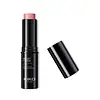What's inside
What's inside
 Key Ingredients
Key Ingredients

 Benefits
Benefits

 Concerns
Concerns

 Ingredients Side-by-side
Ingredients Side-by-side

Isononyl Isononanoate
EmollientMica
Cosmetic ColorantPolyethylene
AbrasiveSynthetic Wax
AbrasiveNeopentyl Glycol Dicaprylate/Dicaprate
EmollientPolymethylsilsesquioxane
Talc
AbrasiveZinc Stearate
Cosmetic ColorantSilica
AbrasiveDimethicone
EmollientEthylene Brassylate
MaskingPentaerythrityl Tetra-Di-T-Butyl Hydroxyhydrocinnamate
AntioxidantPlukenetia Volubilis Seed Oil
EmollientPistacia Vera Seed Oil
Skin ConditioningHydrogenated Vegetable Oil
EmollientTocopherol
AntioxidantBHT
AntioxidantTin Oxide
AbrasiveTitanium Dioxide
Cosmetic ColorantCI 77491
Cosmetic ColorantCI 15850
Cosmetic ColorantCI 19140
Cosmetic ColorantCI 45410
Cosmetic ColorantCI 73360
Cosmetic ColorantIsononyl Isononanoate, Mica, Polyethylene, Synthetic Wax, Neopentyl Glycol Dicaprylate/Dicaprate, Polymethylsilsesquioxane, Talc, Zinc Stearate, Silica, Dimethicone, Ethylene Brassylate, Pentaerythrityl Tetra-Di-T-Butyl Hydroxyhydrocinnamate, Plukenetia Volubilis Seed Oil, Pistacia Vera Seed Oil, Hydrogenated Vegetable Oil, Tocopherol, BHT, Tin Oxide, Titanium Dioxide, CI 77491, CI 15850, CI 19140, CI 45410, CI 73360
Water
Skin ConditioningCyclopentasiloxane
EmollientIsohexadecane
EmollientIsononyl Isononanoate
EmollientTridecyl Trimellitate
EmollientPropylene Glycol
HumectantTrimethylsiloxysilicate
EmollientCetyl PEG/PPG-10/1 Dimethicone
EmulsifyingVinyl Dimethicone/Methicone Silsesquioxane Crosspolymer
Glycerin
HumectantBoron Nitride
AbsorbentSilica
AbrasivePhenoxyethanol
PreservativePhenyl Trimethicone
Skin ConditioningMica
Cosmetic ColorantDisteardimonium Hectorite
StabilisingPEG-10 Dimethicone
Skin ConditioningSorbitan Sesquioleate
EmulsifyingPropylene Carbonate
SolventAcrylates/Dimethicone Copolymer
Skin ConditioningSilica Dimethyl Silylate
EmollientAluminum Hydroxide
EmollientTriethoxycaprylylsilane
Tocopheryl Acetate
AntioxidantEthylhexylglycerin
Skin ConditioningAlumina
AbrasiveParfum
MaskingMethicone
EmollientDimethicone
Emollient3-O-Ethyl Ascorbic Acid
Skin ConditioningSorbitol
HumectantCI 77891
Cosmetic ColorantCI 12085
Cosmetic ColorantCI 15850
Cosmetic ColorantIron Oxides
CI 73360
Cosmetic ColorantWater, Cyclopentasiloxane, Isohexadecane, Isononyl Isononanoate, Tridecyl Trimellitate, Propylene Glycol, Trimethylsiloxysilicate, Cetyl PEG/PPG-10/1 Dimethicone, Vinyl Dimethicone/Methicone Silsesquioxane Crosspolymer, Glycerin, Boron Nitride, Silica, Phenoxyethanol, Phenyl Trimethicone, Mica, Disteardimonium Hectorite, PEG-10 Dimethicone, Sorbitan Sesquioleate, Propylene Carbonate, Acrylates/Dimethicone Copolymer, Silica Dimethyl Silylate, Aluminum Hydroxide, Triethoxycaprylylsilane, Tocopheryl Acetate, Ethylhexylglycerin, Alumina, Parfum, Methicone, Dimethicone, 3-O-Ethyl Ascorbic Acid, Sorbitol, CI 77891, CI 12085, CI 15850, Iron Oxides, CI 73360
 Reviews
Reviews

Ingredients Explained
These ingredients are found in both products.
Ingredients higher up in an ingredient list are typically present in a larger amount.
Ci 15850 is the pigment color red. It is an azo dye and created synthetically.
Azo dyes need to be thoroughly purified before use. This allows them to be more stable and longer-lasting.
This ingredient is common in foundations, lipsticks, and blushes. This color is described as brown/orangey red.
It has many secondary names such as Red 6 and Red 7. According to a manufacturer, Red 6 usually contains aluminum.
Learn more about CI 15850Ci 73360 is a synthetic red-pink dye.
Dimethicone is a type of synthetic silicone created from natural materials such as quartz.
What it does:
Dimethicone comes in different viscosities:
Depending on the viscosity, dimethicone has different properties.
Ingredients lists don't always show which type is used, so we recommend reaching out to the brand if you have questions about the viscosity.
This ingredient is unlikely to cause irritation because it does not get absorbed into skin. However, people with silicone allergies should be careful about using this ingredient.
Note: Dimethicone may contribute to pilling. This is because it is not oil or water soluble, so pilling may occur when layered with products. When mixed with heavy oils in a formula, the outcome is also quite greasy.
Learn more about DimethiconeIsononyl Isononanoate is a synthetic skin-conditioner and texture enhancer. It is created from nonanoic acid, a fatty acid found in cocoa and lavender oil.
As an emollient, Isononyl Isononanoate helps keep your skin soft and smooth. This is because emollients create a barrier on the skin to trap moisture in.
Isononyl Isononanoate helps give products a velvet feel and improves spreadability.
Learn more about Isononyl IsononanoateMica is a naturally occurring mineral used to add shimmer and color in cosmetics. It can also help improve the texture of a product or give it an opaque, white/silver color.
Serecite is the name for very fine but ragged grains of mica.
This ingredient is often coated with metal oxides like titanium dioxide. Trace amounts of heavy metals may be found in mica, but these metals are not harmful in our personal products.
Mica has been used since prehistoric times throughout the world. Ancient Egyptian, Indian, Greek, Roman, Aztec, and Chinese civilizations have used mica.
Learn more about MicaSilica, also known as silicon dioxide, is a naturally occurring mineral. It is used as a fine, spherical, and porous powder in cosmetics.
Though it has exfoliant properties, the function of silica varies depending on the product.
The unique structure of silica enhances the spreadability and adds smoothness, making it a great texture enhancer.
It is also used as an active carrier, emulsifier, and mattifier due to its ability to absorb excess oil.
In some products, tiny microneedles called spicules are made from silica or hydrolyzed sponge. When you rub them in, they lightly polish away dead skin layers and enhance the penetration of active ingredients.
Learn more about Silica